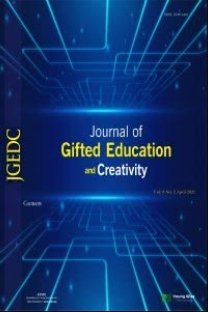Myths about creativity: A qualitative study on gifted students' parents
Giftedness and creativity have been popular research areas especially in the last century. Moreover, giftedness and creativity are interrelated concepts. Although many researchers study different aspects of these two concepts, there are not consensuses on their definitions. Gifted individuals are defined as those who have above-average ability, creativity, and task commitment and combine these three traits and apply these to one or more domains. The inventions and products of the gifted individuals are results of their creativity. Parents of gifted students play a significant role in fostering creativity of their children. Unless the gifted children are given the opportunity to use their creativity, their abilities to discover new things will not be appeared. Although creativity is a significant trait, there are still some myths that are unrealistic opinions about creativity. This qualitative research aims to determine the myths of parents of gifted students about creativity. The data was collected by semi-structured interviews with 12 volunteer parents of gifted students. In order to analyze the qualitative data obtained from the interviews, content analysis was conducted. In the content analysis, data similar to each other are organized by bringing together under themes and data is interpreted. After analyzing the content codes, four themes emerged as: (1) definition of creativity; (2) characteristics of creative people; (3) thinking patterns of creative people; (4) motivation of creative people. The results reveal that myths about creativity are common among parents of gifted students. Believing that creativity is a divine inspiration, linking creativity with personality, thinking that creative people like to take risk and believing that there is a positive relationship between intelligence and creativity are some examples to the common myths about creativity.
Keywords:
giftedness, myths, fostering creativity parent,
___
- Amabile, T. M. (1996). Creativity in context. Boulder, CO: Westview Press.
- Aydoğan, Y. (2006). Ev ortamının çocuğun gelişimine göre düzenlenmesi. Sosyal Politika Çalışmaları Dergisi, 10(10), 27-33.
- Benson, C. (2004). Professor John Eggleston Memorial Lecture 2004-Creativity: Caught or Taught? Journal of Design & Technology Education, 9(3), 138-144.
- Cropley, A. (2016) The Myths of Heaven-Sent Creativity: Toward a Perhaps Less Democratic but More Down-to-Earth Understanding, Creativity Research Journal, 28:3, 238-246.
- Cropley, A. (2018). Bringing creativity down to earth: A long labor lost? In R. J. Sternberg & J. C. Kaufman (Eds.), The nature of human creativity (p. 47–62). Cambridge University Press.
- Csikszentmihalyi, M. (1977). Beyond Boredom and Anxiety, second printing. San Francisco: Jossey-Bass.
- Csikszentmihalyi, M. (1996). Creativity. New York: Harper Collins.
- Dabrowski, K. (1972). Psychoneurosis is not an illness. London: Gryf.
- Guilford, J. P. (1959). Three faces of intellect. American psychologist, 14(8), 469.
- Gute, G., Gute, D. S., Nakamura, J., & Csikszentmihályi, M. (2008). The Early Lives of Highly Creative Persons: The Influence of the Complex Family., Creativity Research Journal, 20:4, 343-357, DOI: 10.1080/10400410802391207.
- Keleşoğlu, S., & Kalaycı, N. (2017). Dördüncü sanayi devriminin eşiğinde yaratıcılık, inovasyon ve eğitim ilişkisi. [On the Threshold of the Fourth Industrial Revolution, Innovation and Education Relationship]. Yaratıcı Drama Dergisi, 12(1), 69-86.
- Maker, C. J. (1992). Intelligence and creativity in multiple intelligences, identification and development. Educating Able Learners, 17(4) 12-19.
- Memduhoğlu, H. B., Uçar, R., &Uçar, İ. H. (2017). Örnek uygulamalarla eğitimde yaratıcılık yaratıcı okul yaratıcı öğretmen.[Creativity in education with sample applications creative school creative teacher].Ankara: Pegem.
- Miles, M, B. and Huberman, A. M. (1994). Qualitative data analysis: An expanded Sourcebook. Thousand Oaks, CA: Sage.
- Ömeroğlu, E. & Turla, A. (2001). Okulöncesi Dönemde Yaratıcılık Eğitimi ve Desteklenmesi, Milli Eğitim Dergisi, 151: 48-52.
- Öztürk, E. (2001). Yaratıcılık ve Eğitim[Creativity and Education].SakaryaÜniversitesiEğitimFakültesiDergisi, (1), 158-164.
- Renzulli, J. S. (1986). The three ring conception of giftedness: A developmental model for creative productivity. Cambridge: University of Cambridge.
- Senemoğlu, N. (1999). İlköğretimde Etkili Öğretmeve Öğrenme El Kitabı: Öğrenm eÜrünlerive Öğretimi. [Effective Teaching and Learning Handbook in Primary Education: Learning Products and Teaching].Burdur.
- Sevinç, N., & Kanlı, E. (2019). Teachers’ Myths and Views about Creativity. Journal of Gifted Education and Creativity, 6(2), 103-122.
- Sungur, N. (1997). Yaratıcı Düşünce [Creative Thinking]. İstanbul :Evrim.
- Torrance, E. P. (1971). Are the Torrance tests of creative thinking biased against or in favor of “disadvantaged” groups? Gifted Child Quarterly, 15(2), 75-80.
- Tortop, H.S. (2018). Yaratıcı Anneye Sihirli Notlar [Magic notes to the creative mom]. Istanbul: Young Wise Publishing
- Whitmore, J. R. (1980). Giftedness, conflict and underachievement. Boston: Allyn & Bacon.
- Yalçın, S. (2018). 21. Yüzyıl Becerileri ve Bu Becerilerin Ölçülmesinde Kullanılan Araçlar ve Yaklaşımlar. [21st Century Skills and Tools and Approaches That Are Used to Measure These Skills]. Ankara University Journal of Faculty of Educational Sciences, 51 (1), 183-201.
- Yıldırım, A., & Şimşek, H. (2013). Sosyal bilimlerde nitel araştırma yöntemleri [Qualitative research methods in the social sciences].Ankara: Seçkin.
- Yayın Aralığı: Yılda 4 Sayı
- Başlangıç: 2014
- Yayıncı: Genç Bilge Yayıncılık
